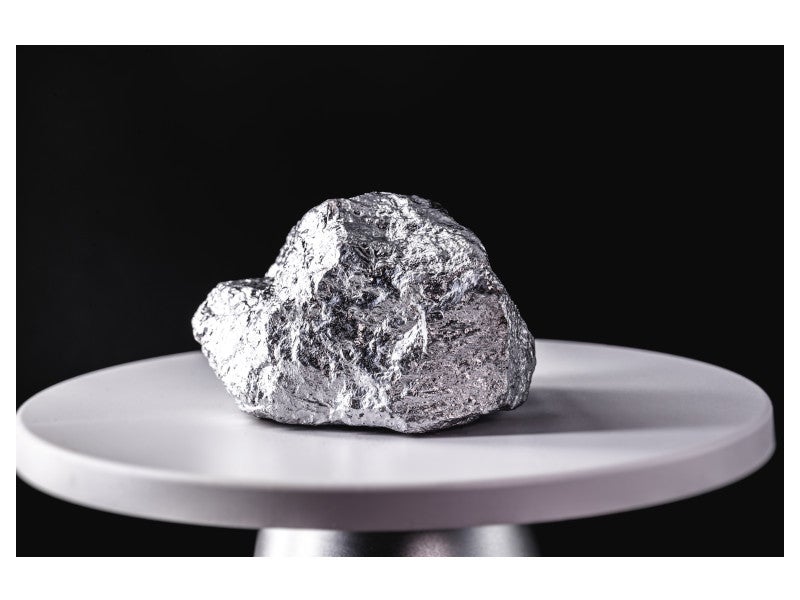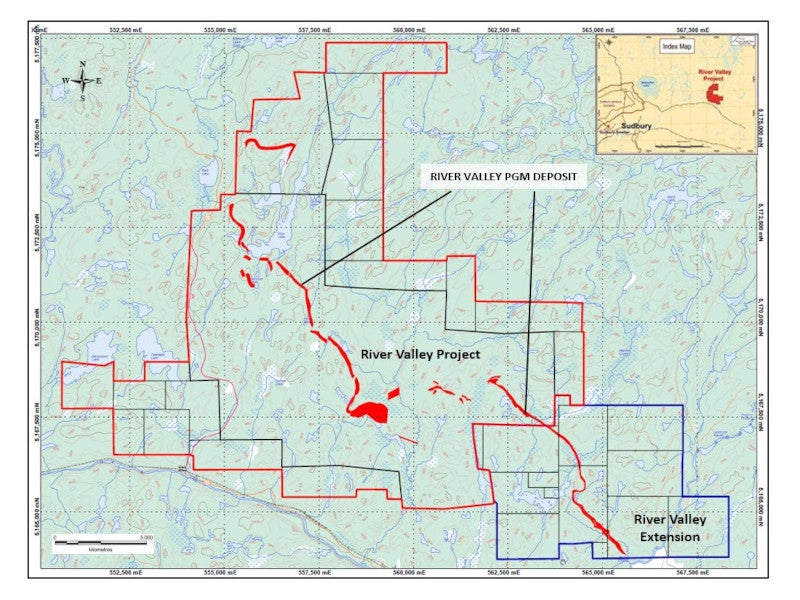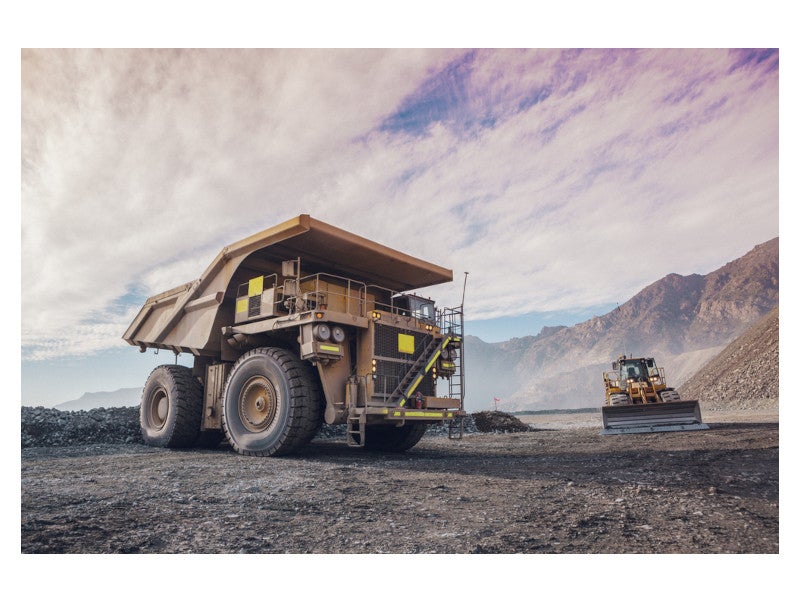The River Valley palladium project is claimed to be one of the largest undeveloped platinum group metals projects in North America. It is located near Sudbury, Ontario, Canada.
New Age Metals, a Canada-based mineral exploration and development company, owns the property encompassing the mine.
The preliminary economic assessment (PEA) for the palladium project was completed in June 2019. It indicated a large-scale open-pit mining operation with a life of 14 years.
The pre-feasibility study (PFS) for the project is progressing and is expected to be completed in the fourth quarter (Q4) of 2022 while the feasibility study is set to begin in 2023.
The project is expected to involve an initial capital expenditure of $495m.
Location and geology of River Valley project
The River Valley property is in the townships of Dana and Pardo, approximately 100km north-east of Greater Sudbury, Ontario.
The River Valley Intrusion (RVI), which is part of the Paleoproterozoic East Bull Lake Intrusive Suite, is a stratified, shallow-dipping deposit with a thickness of 900m. Brecciated and massive leuco-gabbronorite, as well as leucogabbro with gabbro and anorthosite are the major rock types in the area.
The metamorphic grade increases from the northwest portion (greenschist facies) of the intrusion to the southeast part (amphibolite facies).
A copper-nickel-platinum group elements (PGE)-bearing breccia unit is situated at the base of the RVI.
The intrusion intrudes mafic and felsic metavolcanic rocks of the lower Huronian Supergroup in west-central and south-west Dana and is in thrust contact with Huronian Mississagi Formation quartzite along the Grenville Front in north-west Dana.
Mineralisation and reserves of the River Valley project
Mineralisation in the Canadian palladium project area spans nine distinct zones of various thicknesses hosted predominantly in gabbronorite to gabbroic anorthosite.
Contact-type palladium mineralisation with disseminated copper-nickel sulphides was found in ten zones over a strike length of approximately 16km at the magmatic contact-type palladium-platinum-gold deposit.
The project hosts two types of mineralisation, namely contact nickel-PGE mineralisation and reef PGE mineralisation.
The copper-nickel-PGE mineralised host rocks are predominantly found in the breccia unit at the base of the intrusion.
The River Valley deposit is estimated to contain measured and indicated resources of 89.9 million tonnes (Mt) grading 0.54g/t palladium, 0.21g/t platinum, 0.04g/t gold, and 0.06% copper, according to the updated 2021 mineral resource estimate.
Inferred resources are estimated at 94Mt grading 0.35g/t palladium, 0.16g/t platinum, 0.04g/t gold, and 0.06% copper.
Contained metal (palladium, platinum and gold) is estimated at 2.3 million ounces (Moz) in the measured and indicated categories and 1.6Moz in the inferred category.
Mining and processing at the River Valley Project
Conventional open-pit mining is proposed to be employed at the River Valley palladium project due to its shallow depth.
The northwest end of the deposit is planned to be mined first, progressing towards the southeast.
The mining operation will be performed using equipment such as 29m³ hydraulic excavators, 254mm rotary drills, 221t haul trucks, and auxiliary equipment.
Commencement of mining will be preceded by one year of pre-production for pre-stripping. The production plan includes 13 years of mining and a partial final year of stockpile reclaim.
The deposit will be mined at a rate of 40 million tonnes per annum (Mtpa) or 110,000 tonnes per day (tpd). The produced concentrate is planned to be transported to a smelter/refinery in Sudbury.
Processing details of the Canada-based palladium project
The processing plant will have a capacity of 6Mtpa with a throughput of 20,000tpd.
The run-of-mine (ROM) material will be subject to primary crushing before sending to the milling circuit.
The grinding unit will include a closed-circuit semi-autogenous grinding (SAG) mill, a pebble crusher, and two ball mills.
The material will thereafter undergo rougher-scavenger flotation, followed by three stages of cleaner flotation.
High-rate thickeners will be used to dewater the concentrate and tailings products. Traditional plate and frame pressure filtration will be used to further dewater the concentrate.
Infrastructure details
The River Valley palladium project has rail and road connections. The main line of the Canadian National Railway is located south of the mine site.
A 230kV transmission line passing through Warren is located 22km from the site, while a 115kV transmission line running through the town of Field is 15km east of the site. A gas pipeline passing through River Valley is 10km south of the property.
Water needs for exploration and mining activities can be met from local lakes and rivers. NAM, however, plans to mainly use mine water and recycle process water.
The project infrastructure will include mineral processing buildings, offices, a water treatment plant, reagents storage facility, a warehouse, and an electrical substation.
Access roads will be built to provide access to open pits, overburden, and waste rock storage areas. Tailings management facilities will also be built at the site.
Waste rock storage facilities will be located immediately adjacent to the mining areas.
Contractors involved in the River Valley project
SGS Canada is providing metallurgical testing services for the project. Devlin Environmental Consulting Services conducted plant ecology and surface water surveys, as well as an acid rock drainage study between 2002 and 2004.
DST Consulting Engineers, a consulting engineering firm, conducted studies related to surface water, sediment, and benthic zone in 2012. The company undertook baseline sampling and analysis of surface water and sediment.
Local firm Jacob and Samuel Drilling was engaged to undertake a diamond drilling programme at the site. Abitibi Geophysics received a contract to conduct an induced polarisation survey in 2017.
Story Environmental, a Canadian environmental consulting firm, was contracted to conduct surface water quality programmes, hydrological data collection, as well as studies related to fish community and fish habitat between 2020 and 2022.
WSP Canada oversaw the provision of an updated mineral resource estimate for the project in 2018.
DRA Americas, a full-service engineering company, was appointed to support the PEA by providing consulting services for metallurgical test work and processing facility design.
Canada-based geological and mine engineering consulting company P&E Mining Consultants received a contract to undertake the PEA for the project in July 2018. The company also provided the updated mineral resource estimate for the project in 2021.






